by Amineddoleh & Associates LLC | Mar 23, 2024 |
In a highly-public withdrawal, Christie’s pulled four ancient Greek vases from auction. The four antiquities ranged in value from $7,000 to $30,000. It appears that the vases are the product of illicit dealings. They have been traced to the notorious antiquities trafficker Gianfranco Becchina.

One of the four disputed vases pulled from auction. Image via Christie’s.
Vases Traced to Notorious Dealer
Becchina, a well-known middleman in a looting network who was convicted for his actions in 2011, cosigned three of the four vases for a Geneva Christie’s auction in 1979. For the upcoming April 2024 auction, Christie’s listed the vases’ sale in 1979, but failed to disclose the fact that Becchina cosigned the objects. Dr. Christos Tsirogiannis, a lecturer at the Unviersity of Cambridge, called Christie’s nondisclosure “a trick used by the highest level. . . [t]hey deliberately exclude the connection of a trafficker in these three examples, although they’ve known about that connection for 45 years.”
Christie’s has released a statement counter to this effect, stating that the auction house “takes the subject of provenance research very seriously, especially when it related to cultural property.” However, taking the subject of provenance research seriously, and proactively allocating the resources and dedicated staff to carry out the work, are two different things.

A disputed vase pulled from auction. Image via Christie’s.
New Head of Provenance at the Met
In other antiquities news, the Metropolitan Museum of Art is taking a proactive stance. Last month, the museum hired Lucian Simmons (previously of Sotheby’s) as its first-ever Head of Provenance Research. This new position points to the museum’s recent efforts to increase the museum’s number of provenance-specific employees, in an era of greater scrutiny against both private and public collections. An increase in the number of restitutions has occurred during the past few decades, and this new hire makes the Met better situated to research provenance issues and handle requests for restitution. Mr. Simmons’ hiring brings the number of specialized province employees to eleven – an astonishing number for the institution.

Mr. Lucian Simmons. Image via Wilson Santiago/Metropolitan Museum of Art.
Mr. Simmons has extensive experience with provenance research and related issues, due to his long tenure at Sotheby’s. Since 1997, Simmons has developed and deployed transparent provenance policies for the auction house. In fact, transparency is at the heart of all of Simmons’ provenance work. He told to The New York Times that from the beginning of his time at Sotheby’s, he has “always tried to make sure [Sotheby’s was] very open” in the provenance research processes. Simmons intends to continue innovative model of transparency when he transitions to the Met this coming May.
New Awareness for Repatriation of Looted Antiquities
Repatriation actions for looted antiquities are increasingly being brought by countries around the world. Our firm has proudly represented and won legal claims related to looted antiquities on behalf of several nations, including the Republic of Italy and the Hellenic Republic of Greece. The cultural shift towards an increased awareness and respect for repatriation and restitution claims is something our firm both applauds and works to uphold.
by Amineddoleh & Associates LLC | Mar 5, 2024 |
In honor of International Women’s Day and Women’s History Month, our firm is reposting one of our favorite blog posts. This post originally ran on our firm’s blog in 2021.
—
It is a bitter truth that women, who are so often depicted, admired and romanticized through art, have had to overcome herculean obstacles to participate in its creation. In honor of Women’s History Month, this entry in our Provenance Series examines the work of the Old Masters’ female counterparts – the Old Mistresses – and their contemporary successors.
Rediscovery of Female Artists
Renaissance and Baroque works by women have deservedly entered the public consciousness in recent years. In 2019, a depiction of the Last Supper by nun Plautilla Nelli was installed in the Santa Maria Novella Museum in Florence, after a painstaking 4-year restoration by the Advancing Women Artists Foundation (AWA). The project was made possible through the AWA’s “adopt an apostle” crowdsourcing program: private financiers were allowed to “adopt” one of the life-sized disciples at $10,000 each (ever-unpopular Judas was instead funded by 10 backers at only $1,000 each). The oil painting, measuring 21 feet across, is one of the largest Renaissance works by a female artist still in existence. It is also the only work created by a woman during the Renaissance depicting the Last Supper.

Last Supper by Plautilla Nelli (prior to restoration). Image via My Modern Met.
The Provenance and Restoration of Plautilla Nelli’s The Last Supper
The Last Supper was likely created for the benefit of Plautilla’s own convent, the convent of Santa Caterina di Cafaggio in Florence, where it hung in the refectory (dining hall) until the Napoleonic suppression in the 19th century, when the convent was dissolved. It was thereafter acquired by the Florentine Monastery of Santa Maria Novella in 1817. Again, it was housed in the refectory until being moved to a new location in 1865. Scholar Giovanna Pierattini reports it was moved to storage in 1911, where it remained until 1939. It then underwent significant restoration, and returned to the refectory. It would remain on display there for almost forty years, surviving the historic flood of the Arno in 1966 with little damage. The work was next taken down in 1982, when the refectory was reclassified as the Santa Maria Novella Museum, and transferred to the friars’ private rooms. This is how the monumental work, which remained out of the public eye for centuries, is now visible to the public for the first time in 450 years.
Rossella Lari, the restoration’s head conservator remarks, “We restored the canvas and, while doing so, rediscovered Nelli’s story and her personality. She had powerful brushstrokes and loaded her brushes with paint.” The painting features emotionally charged expressions, emphatic body language, and exquisite details, such as the inclusion of customary Tuscan cuisine (roasted lamb and fava beans).
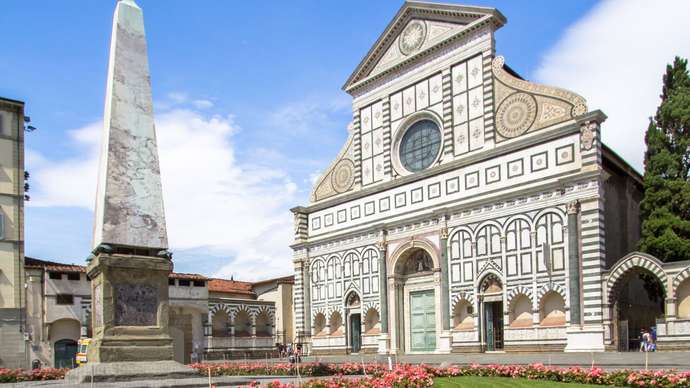
Santa Maria Novella in Florence, Italy. Image courtesy of CAHKT/iStock.com.
Plautilla’s use of color and composition is even more impressive when one considers that women were barred from attending art schools and studying the male nude; instead, they were forced to rely on printed manuals and the works of other artists. Plautilla was not only a self-taught artist, but she also ran an all-woman workshop in her convent and received the ultimate praise for an Italian Renaissance painter: inclusion in Giorgio Vasari’s seminal book Lives of the Most Excellent Painters, Sculptors and Architects. Notably, in Plautilla’s time the convent was managed by Dominican friars previously under the leadership of fire-and-brimstone preacher Girolamo Savonarola. The nuns were encouraged to paint devotional pictures in order to ward off sloth.
Undeterred, “Plautilla knew what she wanted and had control enough of her craft to achieve it,” says Lari. The Last Supper is signed “Sister Plautilla – Orate pro pictora” (“pray for the paintress”). Plautilla thus confirmed her role as an artist while acknowledging her gender, understanding that the two were not mutually exclusive. Although only a handful of the works survive today, Plautilla and her disciples created dozens of large-scale paintings, wood lunettes, book illustrations, and drawings with great focus, determination, and discipline. She is considered the first true woman artist in Florence and in her heyday, “There were so many of her paintings in the houses of gentlemen in Florence, it would be tedious to mention them all.” Since AWA’s conservation work was initiated, the number of works attributed to Plautilla has risen from three to twenty, meaning that other undiscovered masterpieces could be lying in wait.
Female-Led Museum Exhibitions
The Prado Museum in Madrid has hosted an exhibition featuring two overlooked Baroque painters, Sofonisba Anguissola and Lavinia Fontana, in an exhibition entitled “A Tale of Two Women Painters.” Meanwhile, the National Gallery in London hosted a show dedicated to Artemisia Gentileschi. Notably, Sofonisba, Lavinia and Artemisia all achieved fame and renown during their lifetimes, including royal commissions, only to be eclipsed for centuries after their deaths. Sofonisba was particularly sought after for her ability to capture the expressiveness of children and adolescents in intimate portraits, while Lavinia’s commissions displayed a more formal Mannerist style. Artemisia, the subject of the National Gallery’s first major solo show dedicated to the artist, is recognized as much for the strength of her figures in chiaroscuro as for her life story involving sexual assault and trial by torture. Despite considerable difficulties, Artemisia was able to succeed in a male-dominated field and created over 60 works, most of which feature women in positions of power. Artemisia is now hailed as one of the most important painters of her generation and an established Old Mistress in her own right.
Female Artists at Auction
Despite their long slumber in the annals of history, these artists are not only receiving attention in museums, but in auctions as well. In 2019, a painting by Artemisia depicting Roman noblewoman Lucretia shattered records when it sold for more than six times its estimated price at Artcurial in Paris. While estimates originally placed the work at $770,000 to $1 million, the painting was ultimately acquired by a private collector for $6.1 million. Lucretia was discovered in a private art collection in Lyon after remaining unrecognized for 40 years. It was in an “exceptional” state of conservation according to Eric Turquin, an art expert specializing in Old Master paintings previously at Sotheby’s.

Artemisia Gentileschi’s Lucretia (ca. 1630-1640). Image via Getty Museum.
The earlier record for one of Artemisia’s works had been set in 2017, when a painting depicting Saint Catherine sold for $3.6 million. That painting, a self-portrait of the artist, was then acquired by the National Gallery in London for $4.7 million in 2018. This was the first painting by a female artist acquired by the National Gallery since 1991, and the 21st such item in its entire collection, which encompasses thousands of objects. Saint Catherine had been owned by a French family for decades, but its authorship was obscured prior to its rediscovery and sale by auctioneer Christophe Joron-Derem. The painting was acquired by the Boudeville family in the 1930s, but the exact circumstances of this acquisition and the painting’s prior whereabouts were unclear. At the time of the National Gallery’s purchase, museum trustees raised concerns that the work might have been looted during World War II, although there is no firm evidence to support this suspicion. Despite the gaps in the works’ provenance, it was ultimately determined that the painting had been with the family for several generations and Saint Catherine was welcomed to her new home in London.
Recent Attributions
More recently, a painting of David and Goliath was attributed to Artemisia after a conservation studio in London removed layers of dirt, varnish and overpainting to reveal her signature on David’s sword. While the work’s attribution occurred too late for inclusion in the National Gallery exhibition, the owner is apparently delighted to discover the work’s true author and is keen to loan it to an art institution so the public can enjoy the work. This painting was originally acquired at auction for $113,000 and may have been owned by King Charles I – quite an esteemed pedigree and sure to raise its value by a considerable amount.
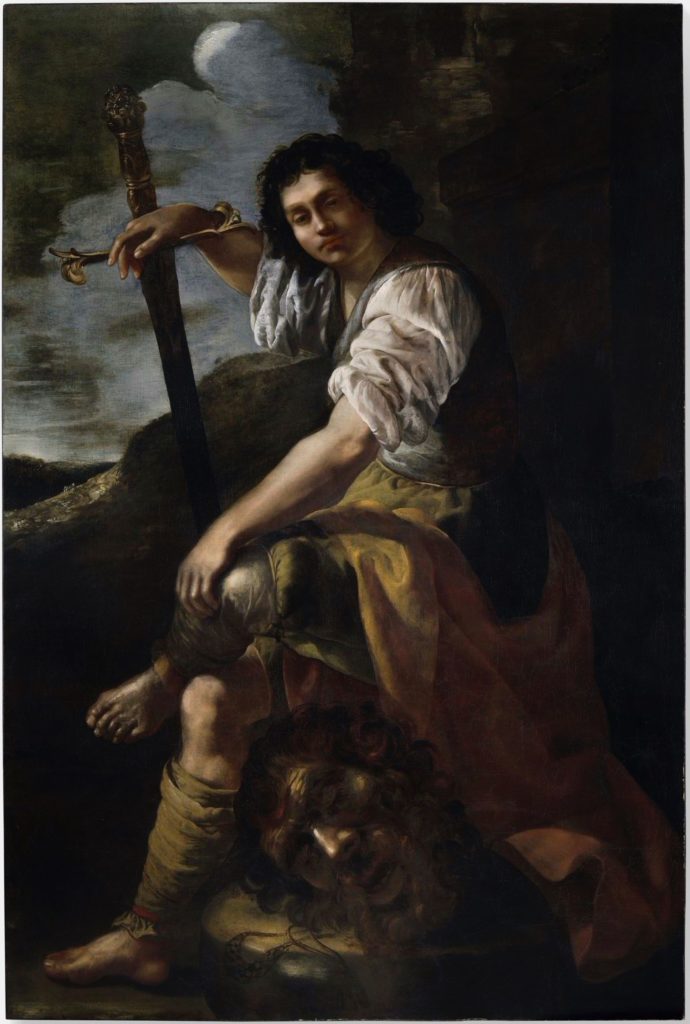
Artemisia Gentileschi, David and Goliath. Image courtesy of Simon Gillespie Studio.
In contrast to Artemisia’s ascendance, a painting once attributed to her father Orazio Gentileschi is now embroiled in controversy. That painting, which also depicts David and Goliath and described as “stunning” by the Artemisia show curator, has links to notorious French dealer Giuliano Ruffini. Ruffini is the subject of an arrest warrant due to his connection with a high-profile Old Master forgery ring operating in Europe. It is believed that the forgery ring, uncovered in 2016, garnered $255 million in sales, including works represented as being by Lucas Cranach the Elder and Parmigianino.
Although these paintings were widely accepted as genuine masterpieces and fooled leading specialists, they did not have verifiable provenances. The paintings were said to belong to private collector André Borie, although that was not the case and Sotheby’s was forced to refund money to buyers once the fraud came to light. The Gentileschi in question had been “discovered” in 2012 and sold to a private collector, who loaned it to the National Gallery in London. At that time, the painting was praised for its “remarkable” lapis lazuli background, but the museum did not conduct a technical analysis before displaying the piece. Despite several warning signs – the painting’s recent entrance into the art market, its unusual material, its similarity to another Gentileschi painting held in Berlin, and the lack of published provenance – the museum stated that there were “no obvious reasons to doubt” the painting’s attribution.
The forgotten nature of some female artists demonstrates that their talents are not rare, but rather that they lack the opportunities and publicity that male artists often take for granted. Once their talent is amplified, female artists are capable of great things. This pattern continues today.
The Modern Struggles of Female Artists
As famous female artists lost to history capture the public eye, they are joined by female contemporaries who share a similar struggle against underrepresentation. Women’s contribution to modern and contemporary art is often exemplifiedby those with ties to established male artists: Mary Cassatt (who achieved recognition as an Impressionist in Paris through her relationship with Edgar Degas); Georgia O’Keeffe (who entered the public eye via her relationship to Alfred Stieglitz); and Frida Kahlo (introduced to the art world by her husband, Diego Rivera). This truncated view ignores the vast amount of creative output generated by women, and reinforces the notion that recognition must be made through a male lens, a view prevalent during Artemisia’s time. It is worth noting that Artemisia’s father Orazio Gentileschi was her teacher and facilitator in the Baroque art market. In fact, this attitude has denied countless female artists of their deserving places in the canon of art history. It has even enabled surreptitious artists to take credit for works by others.
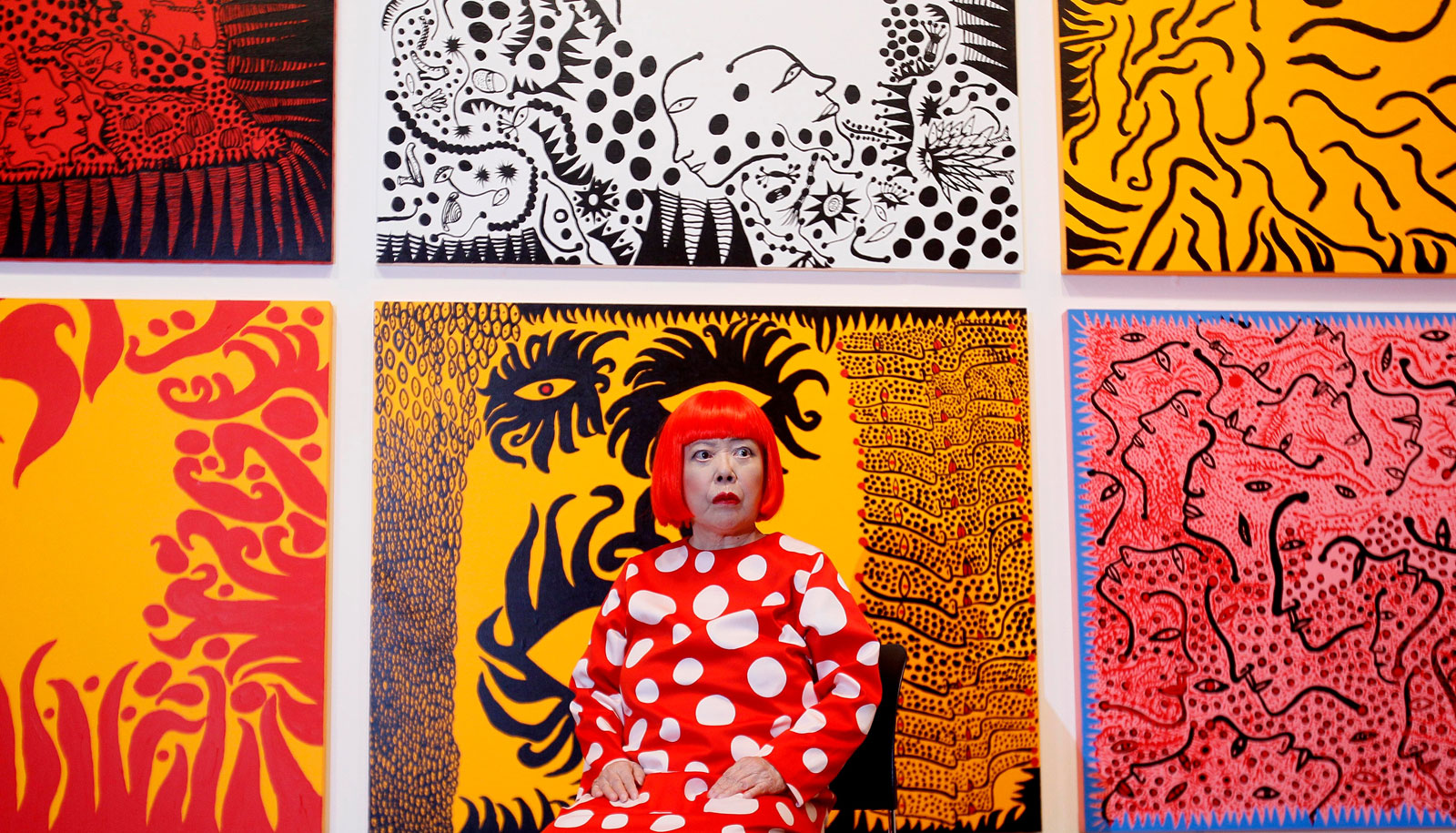
Yayoi Kusama.
Image courtesy of Kirsty Wigglesworth.
Today, Yayoi Kusama is a household name. The world’s top-selling female artist, she is renowned for her peculiar polka-dotted paintings and sculptures, which command long lines at preeminent art institutions across the globe. Like many famous contemporary artists from the last century, she is strongly associated with a unique personal style, and recognized by her bright-red wig. Despite her phenomenal success, her position in the pantheon of notable contemporary artists was anything but assured. Born in the rural town of Matsumoto, Japan in 1929, Kusama was discouraged from pursuing a career; rather, she was encouraged to marry and start a family. Frustrated by the constant efforts to suppress her artistic aspirations, she wrote to the already famous Frida Kahlo for advice. Kahlo warned that she would not find an easy career in the US, but nevertheless urged Kusama to make the trip and present her work to as many interested parties as possible.
Unsurprisingly, Kahlo’s advice was accurate. After traveling to New York, Kusama’s early work received praise from notable artists Donald Judd and Frank Stella, but it failed to achieve commercial success. Her work also attracted the attention of other renowned artists, who were able to channel ‘inspiration’ from Kusama’s work right back into the male-dominated New York art market. Sculptor Claes Oldenburg followed a fabric phallic couch created by Kusama with his own soft sculpture, receiving world acclaim. Andy Warhol repurposed her idea of repetitious use of the same image in a single exhibit for his Cow Wallpaper. Most blatantly, after exhibiting the world’s first mirrored room at the Castellane Gallery, Lucas Samaras exhibited his own mirrored exhibition at the Pace Gallery only months later. Needless to say, these artists did not credit Kusama for her work and originality. This ultimately caused a despondent Kusama to abandon New York and return to Japan.
Kusama spent the next several decades largely in obscurity. The frustrations in her career resulted in multiple suicide attempts and long-term hospitalizations. However, Kusama always found a way to channel this energy back into her art, and she continued to create art in various formats as a way to heal. It was not until a 1989 retrospective of her work in New York and an exhibition at the 1993 Venice Biennale that the world truly tok notice of her work. This global reintroduction was enough to galvanize interest in her artistic creation, leading to the success she enjoys today. While it may seem just that such a talented artist would eventually receive recognition for her work, this is not always a given and Kusama’s near erasure from the art world should not be discounted.
The Gendered Art Market Divide
In today’s art market, artists, collectors, dealers, and museums are making a concerted effort to fight this type of erasure. Kusama stands as a beacon to others, demonstrating that female artists can reach the pinnacle of their profession. However, it remains an arduous career path for many. Statistical analysis confirms that female artists are underpaid and underrepresented in both the primary and secondary art markets. For example, compare the highest price paid for a work by a living artist by gender: Jeff Koons’ Rabbit sold for $91.1 million in 2019; while Jenny Saville’s Propped sold for $12.5 million that same year, a mere 14% of the Koons’ price. Some of this disparity can be explained by the difference between men and women’s treatment in the workplace generally, but the art world is also subject to a number of particularities. Attributed to a host of causes, perhaps none is more prominent than women’s almost total exclusion from studio art until the 1870s. The art world has existed in this environment for so long that its institutions and relationships now mechanically reinforce the disparity between genders: women are less likely to receive recognition and training, and buyers are less interested in art created by females. The interest in female-made art is also disproportionality concentrated on its biggest names; the top five best-selling women in art held 40% of the market for works by women auctioned between 2008 and 2019. It has become a self-sustaining cycle that can only be broken through deliberate and effective action.
Initiatives Supporting Female Artists
Artists and galleries have been working to shine a light on the current landscape of inequality in the market. Groups like the Guerilla Girls have used their cultural status and notoriety to vocalize issues regarding sexism, racism, and other types of discrimination still rampant today. This type of radical-meets-reformer message resonates with a newer generation that is more vocal about addressing discrimination, and frustrated by the seemingly lackluster efforts to minimize their impact on society. In honor of Women’s History Month, several galleries have announced shows dedicated to addressing some of these issues. The Equity Gallery is presenting “FemiNest,” a collection of works by female artists centered around the literal and metaphorical ideas conjured by the idea of a “nest.” The show explores in sculpture, textiles, painting and other media the new spaces that have opened for women in recent decades and their practical and spiritual impact for women. The Brooklyn Museum has announced a retrospective of Marilyn Minter’s work titled “Pretty/Dirty” aimed at challenging traditional notions of feminine beauty. Featuring more than three decades of work, the show will track Minter’s progress throughout the 1970s, 80s, and 90s. The show is also part of a larger series of ten exhibitions by the Brooklyn Museum dedicated to the subject: “A Year of Yes: Reimagining Feminism at the Brooklyn Museum.” Lastly, the Zimmerli Art Museum will feature an exhibition of works by the Guerilla Girls and other female artists who have worked to depict women’s unequal treatment in the art world, “Guerrilla (And Other) Girls: Art/Activism/Attitude.” (For more information about these shows and others addressing similar issues, see here.)
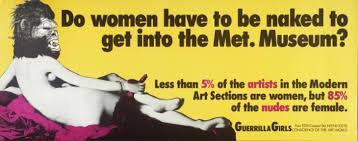
Do Women Have To Be Naked To Get Into the Met. Museum? (1989), Guerrilla Girls. Image via the Met.
Although artists and art institutions have just begun the work of winding back centuries of discrimination, there is evidence that their work is already affecting the market. The percentage of female-generated artwork in the secondary market is increasing from year to year; from 2008 to 2018, the market more than doubled from $230 million to $595 million. Similarly, representation of women at major art shows is steadily, if inconsistently, increasing as well. This subtle shift in the market has been attributed at least in part to a new class of art purchaser: independently wealthy women, whose capital is self-made rather than inherited or shared via marriage. This novel source of demand is less sensitive to the traditional pressures of the market and is helping to fuel demand for works by female artists. Women’s History Month is an opportunity to reflect on the tremendous progress made by remarkable individuals in the art world, and to also contemplate the ripe opportunities that still lie ahead.
by Amineddoleh & Associates LLC | Jan 23, 2024 |
Our firm is thrilled that this is Master Drawing New York’s (MDNY’s) first year with our client, Christopher Bishop Fine Art, at the helm. This highly-anticipated, week-long event is the premiere art exhibition of works on paper in the United States. Over two dozen galleries on the Upper East Side will feature rare and exquisite works on paper, in addition to some paintings, sculptures, and photographic works. The selected works range in date, with some pieces dating back to the 15th century.

Brochure cover for MDNY 2024. Image via Master Drawings New York.
Those who wish to walk the entire show (despite forecasts for rainy weather) will find that they easily meet their step-goals for the day – MDNY stretches 40 city blocks. In addition to the various exhibitions spanning the fair, several events and lectures will take place in different locations throughout the week. Those interested in attending should be sure to pick up an exhibitor map and calendar at one of several spots in the city, lest they miss out on an exclusive, once-in-a-lifetime event.
Highlights
One of the highlights of the fair comes from our very own client. Christopher Bishop Fine Art will exhibit The Pharoah’s Judgment, an exceptionally rare Spanish drawing discovered at auction in early 2023. The 16th century drawing contains tiny pin pricks throughout the pattern of the drawing. These pin pricks indicate that the pattern was replicated on ecclesiastical garments. MDNY has chosen to exhibit this work in a double-sided frame, in order to best showcase how the maker of the drawing collaborated with the embroiderers on the finished garments.This gives viewers a fascinating inside-look into artist collaborations in the 16th century.
Spirit of Partnership
Speaking of collaborations, this year marks the start of a new, great one. MDNY is partnering with The Drawing Foundation, a New York-based not-for-profit organization whose mission is to advance knowledge and scholarship about drawings. The Drawing Foundation establishes this goal through collaborations with various partners around the world. Our firm applauds MDNY, and, by extension, Christopher Bishop Fine Art, for engaging in this fresh collaboration with The Drawing Foundation. The partnership is sure to foster the newest generation of scholars, students, curators, and appreciators of artistic works on paper.
Collaboration – among artists, galleries, collectors, and audiences – hits at the heart of MDNY itself. The events this week are not to be missed, not only because they are a chance to experience gorgeous art, but because they present an opportunity for the international art community to come together in scholarship and art appreciation.
No one says it better than Christopher Bishop. “All of us who work with drawings — museums, dealers, collectors, and historians alike — are invested in seeing that the joy of the study of drawings is passed on to new generations. This can only be done by knitting the community together ever more strongly and introducing new audiences to the fair.”
by Amineddoleh & Associates LLC | Dec 10, 2023 |
In our annual holiday newsletter, Amineddoleh & Associates is pleased to share some of the major developments that took place at our firm and in the art market during 2023. We had a banner year, as we were grateful to work with many returning clients, as well as new ones, including museums, collectors, galleries, artists, and entrepreneurs. We are pleased to share some holiday JOY from us to you.

Grand Central Station. Image courtesy of NannFilms, used with permission.
CLIENTS AND REPRESENTATIVE MATTERS
Hiroshi Sugimoto’s Point of Infinity
Our firm proudly announced the public art unveiling of our esteemed client Hiroshi Sugimoto’s Point of Infinity. The gravity-defying sculpture maintains an optical illusion that the two points of the work will (eventually, even if only in the viewer’s minds’ eye) meet. It is a testament to the genius of Sugimoto as an artistic force. Read more here.
Client Acquires Master Drawings in New York
We proudly represented our client Christopher Bishop and his eponymous Christopher Bishop Fine Art in the acquisition of the art fair Master Drawings in New York. The fair, held annually in January in New York City, focuses on works on paper and features several important galleries, as well as programs with leading institutions. Interested in attending the 2024 event? Mark your calendars for opening day on January 27th. Read more here.
Client Opens New Gallery Space
Our firm was pleased to work with Atamian-Hovsepian Curatorial Practice as it transitioned from freelance curating to unveiling its own inaugural gallery and exhibition space in New York City, focusing on underrepresented artists.
Antiquities Restitutions
Amineddoleh & Associates was involved in a number of cultural heritage restitutions this year, including the return of a valuable marble statue to its country of origin and the return of a collection of historic artifacts to their home overseas.

Snow-covered cabin. Artwork courtesy of Justin Leitner, used with permission.
ART & IP NEWS
One thing we love about the art market is that there is always something unexpected and exciting happening in the art world. Read on for a glimpse at some of our most popular blog posts this past year.
Commercialism v. Transformativeness
In this blog post, our firm examined shifts in copyright law following the decision in Andy Warhol Foundation for the Visual Arts, Inc. v. Goldsmith, et al. This highly-anticipated Supreme Court decision involved application of the fair use test (a test used to determine whether the use of a copyrighted work may be used without permission) to a case with peculiar facts: a photographer (Goldsmith) provided a limited license through Vanity Fair that allowed another artist (Warhol) to use her photograph to create a silkscreen work. Warhol violated the terms of the license, and trouble ensued. Legal scholars hoped that the decision would provide clarification on the test. Unfortunately, the high court’s opinion did not provide much guidance. Curious as to why? Read more here.
Wise Women in Art & Entrepreneurship
Ever wonder where all the great women artists were in your art history lectures? At Amineddoleh & Assoc., we did, too. In honor of International Women’s Day, our firm took a closer look at some of the most talented and undercelebrated women artists in history. We also highlighted our friends at Building 180 – a standout, full-service global art production and consulting agency filling the gap between artists and businesses to create public and private art installations. Read more on our website.
Armenian Cultural Heritage at Risk
Our firm took an exclusive look at the Armenian cultural heritage at risk due to aggression from the Azerbaijani regime. The exodus of Armenians and Azerbaijan’s occupation of Artsakh left Armenian art and architecture unprotected. Artsakh is known as the “Crown Jewel” of Armenian cultural heritage, as it contains some of the most exemplary representations of medieval Armenian architecture, as well as important sites such as the first school to teach the Armenian alphabet in the early fifth century. Also in this post, our firm highlighted the new legal pathway the Republic of Armenia paved when seeking assistance from international courts to help protect their treasures. Read more here.

Christmas ornaments on 6th Ave. Image courtesy of NannFilms, used with permission.
LAW FIRM UPDATES AND EVENTS
Firm Founder Listed Again by Chambers
For the second consecutive year, firm founder Leila A. Amineddoleh was recognized by Chambers and Partners High Net Worth Guide for her work in Art and Cultural Property Law. The publication named Leila as an attorney who has “a lot of expertise in the cultural property space,” with “a great courtroom manner.” The publication also remarked on her active presence in the art law space and her work in the litigation area. Read more here. Leila was also named one of the “Top 10 Most Influential Art and Cultural Property Law Lawyers in 2023” by Business Today. For that award, Leila was selected for her “unique touch of fervor to her work, combined with a comprehensive understanding of art law.” Read more about that award here.
Art Law Conferences
Congratulations to our firm’s founder Leila A. Amineddoleh, who successfully chaired the 15th Annual NYCLA Art Law Institute, one of the most anticipated events of the year. Leila also moderated a fascinating panel during the event entitled “Broken Promises: Promised Gifts and Legal Enforceability.” A major theme in the panel was for lawyers to be extremely aware of the time between the time the gift was made, and the time the gift is executed (word to the wise: things can change!).
Yelena Ambartsumian gave a presentation at the conference with Claudia Quinones, one of our former associates (and current friend). The two gave thoughtful insight and wisdom on issues surrounding title and authenticity.

Santa Con NYC in Central Park. Image courtesy of Nycmstar, used with permission.
IN THE PRESS
Leila appeared in the Washington Post and in an article for ABC News this year, in addition to other notable publications. In each, she was consulted as an expert voice on a variety of art and cultural heritage law topics, including discussions on the ethical implications of resolving cultural antiquities ownership disputes.
Additionally, Leila was invited to contribute to the Third Edition of The Art Law Review. Her article, “Cultural Heritage Disputes and Restitution” examines Nazi-looted art disputes, antiquities litigations, government seizures, and ethical concerns related to the acquisition and display of Colonial-era takings. Read more here. Another of Leila’s scholarly publications, “Kings, Treasures, and Looting: The Evolution of Sovereign Immunity and the Foreign Sovereign Immunities Act,” was published in the Columbia Journal of Law & the Arts. Read more here.

Christmas tree at Rockefeller Center. Image courtesy of NannFilms, used with permission.
Leila also was featured in New York Metro Super Lawyers Magazine as a leader in her field. For the article, Leila’s was highlighted as an exemplary, top-rated intellectual property, art, and cultural heritage lawyer well-known in the industry for getting the job done right. Read more here. Leila was also the feature story in Boston College Magazine’s Winter 2023 issue. The story followed Leila’s art law career along with the story of the looted marble bust that was restituted to Germany in 2022. Read more here.
Maria T. Cannon contributed several letters to the Wall Street Journal this past year on AI and the ethical implications of attorneys and artists. She was also published in the ABA’s Art & Cultural Heritage Law Newsletter, Spring 2023 Edition. You can read it here. She also presented two lectures this past year. The first was in Asheville, NC, about the challenges attorneys face when dealing with celebrity-inspired art. Read more here. The second was at Cardinal Gibbons High School on Nazi-looted art. Finally, she completed Artificial Intelligence Governance Professional training through internationally-recognized leader in privacy, information, and cybersecurity law, IAPP.

White birch forest. Artwork courtesy of Justin Leitner, used with permission.
On behalf of Amineddoleh & Associates, we wish you a happy and healthy holiday season and a wonderful and prosperous new year.
P.S. Click here for one last special holiday message from our firm!
by Amineddoleh & Associates LLC | Dec 7, 2023 |
It’s official – The Gingerbread City has come to New York.

The Gingerbread City’s futuristic cityscape. Image via The Seaport.
Residents of FiDi are already in-the-know and can reportedly smell the cookie houses throughout their neighborhood. A miniature city of futuristic houses entirely constructed of gingerbread and candy is on display at the Seaport – with gingerbread baked courtesy of Balthazar. These professionally-built cityscapes are easily mistaken for pricey works of art. Premier architectural minds used their applied their training to produce a verifiable wonderland of delicious fun.
Those wandering the candy-cane lanes at The Gingerbread City in NYC may wonder where all of this gingerbread madness started – and when the qualifications for a “good” gingerbread house maker suddenly amounted to the same as those required of a minor Renaissance master.
Gingerbread houses are not a new phenomenon, but the artistry behind them is a modern cultural trend. The earliest villages of cookie-built houses originated in Germany, inspired by fairytales.
History of Gingerbread Houses
Remember the story of Hansel and Gretel? Apart from being a harrowing tale told to young children (teaching kids to – above all – never leave crumbs on the floor), the story is supposedly responsible for candy-constructed houses. The original 1880s fairytale reads: “When they [Hansel and Gretel] came nearer, they saw that the house was built of bread, and roofed with cakes, and the window was of transparent sugar.” Alternate translations referred to the “bread” as “gingerbread.” This was great news for German bakers, who were already well-versed in the art of lebkuchen, or “spiced-honey biscuit”-making. They took the Grimms’ cue and ran with it, creating delectable confections of miniature houses with cookie walls, held together by frosting.

Hansel and Gretel. Image via A Child’s Book of Stories (1911), public domain.
Centuries later, bakers around the world still construct houses that look (and usually are) good enough to eat. However, in modern times, yearly competitions have raised the stakes. Take, for example, the Annual National Gingerbread House Contest at Asheville, NC’s Grove Park Inn. That nation-wide conference culminates in a display of hundreds of incredibly detailed and awe-inspiring works of culinary magic. Each house is more than a cobble of cookies and candy – it is a work of art.
Modern Bakers Take the Cake
To come out on top at the Grove Park Inn, contestants must go beyond the traditional gingerbread house. Instead, winners in each category shine with their originality and ingenuity. This past year, judges mulled over 200 entries from twenty-two states and Guatemala to choose the winners. Adult, teens, youth and children battled in out in the sweetest battle outside of Cupcake Wars. Winners walked away with more than just bragging rights. At the end of the day, over $40,000 in cash and prizes was up for grabs.

A traditional gingerbread house. image courtesy of Marit & Toomas Hinnosaar via Wikimedia Commons.
Entrants were scored on metrics appropriate to the task at hand. These includes “Best Use of Color,” “Best Use of Sprinkles,” “Most Unique Ingredient,” “Pop Culture Star,” “Most Innovative Structure,” and “Longest Standing Competitor.” Each gingerbread house was required to be constructed of 5% gingerbread and be 100% edible – no small feat, considering the vast majority of these houses looked like they came out of an artist’s studio, not a kitchen.
Skeptical? Just consider this year’s grand-prize winner – a mini Indonesian-inspired dwelling entitled “Christmas at the Tonkonan” built by an aunt-and-niece duo. The breathtaking piece includes a lattice room, palm fronds, detailed “woodwork”, and tiny home-dwellers – ready to celebrate the holiday of their little lifetimes.
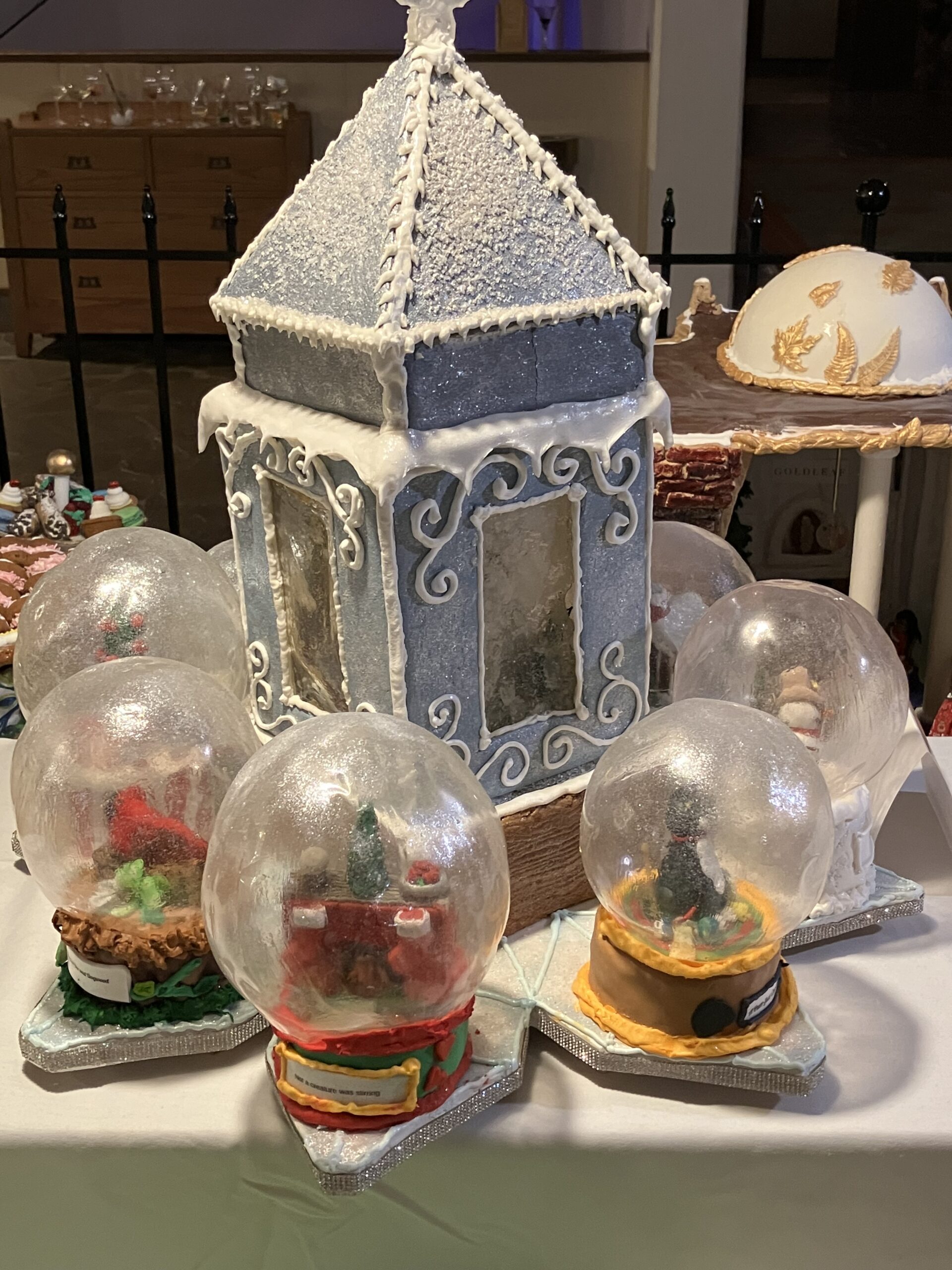
A snow globe themed entry at the 31st Annual National Gingerbread House Competition hosted by the Omni Grove Park. Image courtesy of Maria Cannon, used with permission.
The houses at the Grove Park – while unbelievably beautiful – do stray from the traditional gingerbread house form. Those looking for a more traditional (yet still impressive) way to whet their gingerbread house appetite this year can look no further than the life-size gingerbread house at the Fairmont Hotel in San Francisco.
Life-Size Gingerbread House
It’s true – not only is the Fairmont the former haunt of famed San Franciscan artist Leroy Neiman (who was known to doodle on menus while waiting to be served at tea), it is also the West Coast’s Christmas Central.
Dubbed “Festive Holidays at the Fairmont,” guests can enjoy all sorts of holiday hoopla. However, the real stunner is the life-size gingerbread house in the lobby. Constructed of hundreds of bricks made by staff pastry chefs, this house is the one all the gingerbread men on the block are clamoring to move into. (You thought the New York housing market was rough? Try finding real estate fit for life as a cookie.)

Life-size gingerbread house at the Fairmont Hotel in San Francisco. Image via Fairmont San Francisco.
At the Fairmont, the gingerbread house is not for sale – and no prizes are awarded – but lucky guests may score the chance to tour the inside of the house. Jury’s out as to whether anyone has actually been brave enough to take a bite out of the walls while on the private tour, but hotel staff claims that they have seen guests pawing at the pounds of See’s Candies adorning the windowsills.
Gingerbread Decorating Is The New Culinary Art
Whether big or small, the culinary confections bakers are turning out this time of year deserve our appreciation and recognition. The time, talent, and craft that is required to decorate houses of this detail and magnitude is nothing short of artistic genius. In fact, according to the Culinary Institute of America (CIA), art courses are now a required component of educational programs for master pastry chefs. The class is called “Principles of Design” and the syllabus reads like it’s straight out of Parsons – students learn how to shade, combine colors, plan, sketch and create art across multiple media.
Other modern artists and designers have taken this as a cue to apply their skills (honed in traditional artistic settings) to the art of pastry decorating, including gingerbread house making. Last year, designer Kelly Wearstler and Richard Christiansen (owner of the luxe Flamingo Estate) collaborated with Balthazar’s pastry chef, Mark Tasker, to create a limited-edition gingerbread house offering. Only 100 houses were produced, and proceeds from the (substantial) sales price went to Structure, a charitable initiative that helps communities rebuild sustainable houses after natural disasters.

Kelly Wearstler’s gingerbread creation. Image via Flamingo Estate.
The unique house – done in Kelly Wearstler’s signature California Modernist style – looked like it belonged in California in the 1940s. The innovative design featured a checked exterior and clean, architectural lines. In short, it was iconic and bold, and lived up to the hype of her stated intention prior to starting the project, which was to “build a type of gingerbread house [she and Christiansen] would actually like to live in.”
Wearstler’s design, combined with Tasker’s skill as a baker, fueled holiday magic in the most delicious of forms. The pair created art fit for auction at Sotheby’s, or for display in any art museum in New York or L.A.. Wearstler found the process so intriguing and inspiring from a design perspective that she applauded the gingerbread base as being “the ideal canvas” for her vision to take shape.
At this time of year, and especially in the face of the modern political, economical, and environmental crises impacting our communities, there is something so valuable about the act of taking time to experience art in all its festive forms. For gingerbread house artists, the entire process is akin to artistic masters hard at work in-studio. Here’s to the gingerbread house bakers – the amateur and the masters – who bring us all to stop and wonder at their art of baking.
Want to try your own hand at baking a gingerbread house? Click here for King Arthur Baking’s “construction gingerbread” recipe.
Rather buy your own, already-crafted work of edible art? Look no further than Solvang Bakery‘s creations.





















